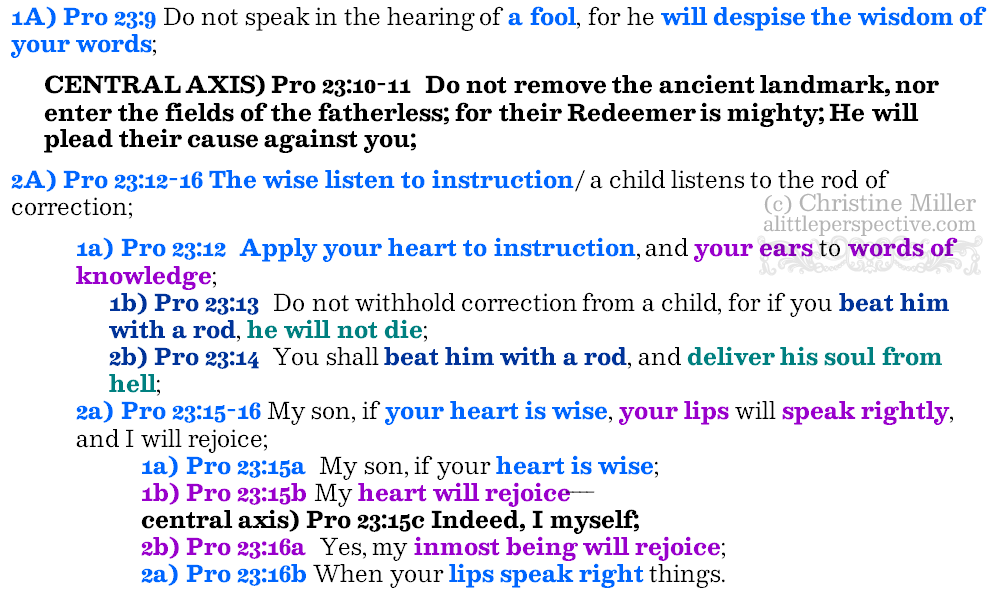Read Proverbs 23 at Bible Gateway.
Hebrew paragraph divisions
Pro 23:1-5 {p} As a ruler’s delicacies are deceptive food, so riches are deceptive security
Pro 23:6-24:14 {p} Desire + pursue wisdom, its benefit endures/ evil, gratification of the flesh is fleeting
Pro 23:5a Will you set your eyes on upon it? It is gone; {n}
Pro 23:5b For riches certainly make themselves wings; They fly away like an eagle toward heaven. {p}
Pro 23:7a For as he thinks in his heart, so is he. {n}
Pro 23:7b “Eat and drink!” he says to you, But his heart is not with you.
Pro 23:29a Who has woe? Who has sorrow? Who has contentions? Who has complaints? Who has wounds without cause? {n}
Pro 23:29b Who has redness of eyes?
Pro 23:35a “They have struck me, but I was not hurt; They have beaten me, but I did not feel it. {n}
Pro 23:35b When shall I awake, that I may seek another drink?”
Pro 23:9-16 chiastic structure
We saw in the last chapter that foolishness is bound up in the heart of a child, but that the rod of correction would drive it far from him. Here we see that the wise listen to instruction, but a child (whose heart is bound up with foolishness) listens to the rod. I wrote “rod of correction” even though verses 13 and 14 just speak of the rod, because we saw in the last chapter that there is a difference between the rod of anger and the rod of correction. The rod of anger will fail, but the rod of correction will succeed in driving foolishness far from the heart of a child.
Correction is Strong’s H4148, muwcar, a concrete noun meaning “instruction, correction, chastisement;” from Strong’s H3256 יסר yacar, a primitive root meaning, “to chastise, to instruct, to correct.” The ancient pictographs are yud + sin + resh.
yud י = the closed hand, thus work, throw, worship
sin ס = the thorn, thus grab, hate, protect
resh ר = the head of man, thus head, first, top, beginning, man
There are two pictographs of hands in the ancient Hebrew alephbet. The yud is the closed fist, and carries the meaning of working or even fighting. The kaph is the open palm, and carries the meaning of blessing. When a father pronounced his blessing over his son, he laid his open palm on his son’s head. Also when one man extends courtesy, hospitality, or friendship to another, he extends his open hand to him, not his closed fist. When one man gives another man anything he opens his hand to release the item from his possession.
So in the days of Patriarchs, the father or eldest son of the tribe, the one who received the birthright and blessing of the father (kaph), would sit in the door of his tent, and the sons of the tribe would come to him with their disputes, and he would render judgment (yud) between them, which was binding. Even in later days you read of the elders sitting in the gate – the entrance – of the city, where the same function of dispensing wisdom, and of rendering decisions, was carried out (see Est 2:21, 3:3).
The sin sometimes carried the meaning of turning, because when someone encountered a thorn along the way, they turned away from it to avoid it. Now we can understand the parable being told of correction. It is judgment (yud) which turns (sin) the head (resh); i.e., sets someone going in a different direction.
Anger is Strong’s H5678, ebrah, an abstract concept meaning, “wrath, rage, anger;” from the sense of an outpouring, outburst, or overflow of passion; from Strong’s H5676, eber, a concrete noun meaning, “region beyond;” from Strong’s H5674 עבר abar, the primitive root meaning, “to pass over, to cross over.” The ancient pictographs are ayin + bet + resh.
ayin ע = the eye, thus watch, know, shade
bet ב = the house, thus house, household, family, in, within
resh ר = the head of man, thus head, first, top, beginning, man
The story being told is to see with a discerning eye (ayin) the family (bet) of heads (resh), i.e., grain, as mature wheat or barley formed a family of seeds in the seedhead, which then filled the land, according to the Ancient Hebrew Lexicon. This is the same primitive root from whence firstfruit comes, for when the harvest – that which filled the land – or the flock or the herds, were gathered in, the owner’s discerning eye chose out the best of it for the firstfruits offering, and set it apart from the rest.
Anger is derived from this same primitive root, in the sense of that which fills the land, that which is overflowing. Water passes over and fills the land when the river rises and overflows its banks. Anger is an increase in emotion that rises and overflows restraint in an outburst.
The difference between the rod of correction and anger, then, is that the one wielding the rod of correction keeps a restraint on his emotion, being guided by good judgment in meting out judgment. The one wielding the rod of anger does so in an outburst of wrath which overflows restraint.
A child listens to the rod of correction; it delivers his soul from hell; but the rod of anger will fail in accomplishing that mission.


















Leave a Reply